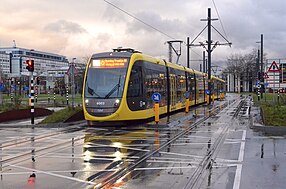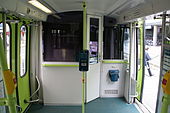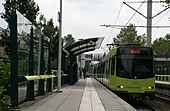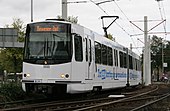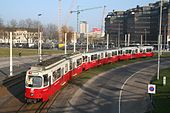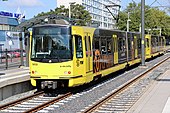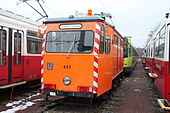Utrecht light rail
| Utrecht light rail | |
|---|---|
| Car 6003 in the De Uithof university complex | |
| Basic information | |
| Country | Netherlands |
| city | Utrecht |
| opening | 17th December 1983 |
| operator | U-OV |
| Infrastructure | |
| Route length | 28.7 km |
| Gauge | 1435 mm ( standard gauge ) |
| Power system | 750 V DC overhead line |
| Stops | 32 |
| business | |
| Lines | 3 |
| vehicles | 26 SIG light rail vehicles 27 CAF Urbos 100 |
| Top speed | 80 km / h |
| statistics | |
| Passengers | 39,000 per day (as of 2012) |
| Residents in the catchment area |
455,265 thousand |
| Line network 2020 including the first tram network until 1949 | |
The Sneltram Utrecht ( Dutch Utrechtse sneltram , otherwise also Stadtbahn Utrecht , u tram , formerly Sneltram Utrecht - Nieuwegein / IJsselstein or SUNIJ, SUN for short ) is a light rail system in the Dutch city of Utrecht , as well as its suburbs Nieuwegein and IJsselstein , which has existed since 1983 .
On weekdays between 38,000 and 40,000 people take the Utrecht light rail, most passengers (25,000 to 30,000) use the section between the main station and the canal island (as of 2012).
history
At the end of the 19th and beginning of the 20th century, first-generation trams were running in the city and province of Utrecht. The Utrechtsche Tram-Maatschappij (UTM), from 1904 Gemeentetram Utrecht (GTU), operated up to five lines in city traffic from 1889 to 1939. In addition, there was an overland tram to Zeist from 1879 to 1949 , initially operated by the Stichtsche Tramway-Maatschappij , taken over in 1901 by the Nederlandsche Buurtspoorweg-Maatschappij .
In order to connect the city of Utrecht with the new development area Nieuwegein (with the existing village centers Vreeswijk and Jutphaas ), one had both an S-Bahn (as with the previously opened railway line Den Haag-Zoetermeer , today part of the RandstadRail network), a trolleybus and an express tram (literally Dutch sneltram ) is being considered. In the case of the railway variant, the tracks from the Utrecht – Boxtel line were to branch off at the bridge over the Autobahn 12. In anticipation of the construction of the railway, the destination “Nieuwegein” was already included on the target film of the first Sprinter trains.
The choice finally fell on the express tram. It was built by the Nederlandse Spoorwegen , the Dutch railways. However, the operation was assigned to the bus company Westnederland (later Midnet ) from the start, as bus drivers could be retrained to the double function of bus and tram drivers. Connexxion operated the route as legal successor to Midnet from 1999 to 2013 , then the concession was awarded to Qbuzz , a subsidiary of the Nederlandse Spoorwegen, which operates public transport in Utrecht as u-ov (abbreviation for both Utrecht public transport and your public transport ) marketed. ProRail operated the infrastructure with the exception of the stops until 2010.
On December 17, 1983 the line 100 on the section Moreelsepark - Nieuwegein-Zuid and the line 101 Moreelsepark - Nieuwegein Doorslag began. On December 14, 1985, line 101 was extended to the Achterveld stop in IJsselstein. In 1994 the lines were renumbered 60 and 61 when Midnet was created. However, only the destination and not the line number is displayed on the railways.
On July 2, 2000, line 61 was extended from IJsselstein Achterveld via IJsselstein Binnenstad to IJsselstein-Zuid in the new Zenderpark development area.
As part of a broader overhaul of the station Utrecht Centraal was 13 December 2009 until the current terminus Moreelsepark and on 22 April 2013, the stops Centraal Station (on the eastern railway station side) and Westplein shut down and instead on the western side one stop Centraal Station -Jaarbeursplein built.
On June 9, 1989, the Utrecht city council decided under the parties VVD , PvdA , CDA to extend the light rail from the main station to the university campus at Uithof, but through the city center of Utrecht (route of bus line 28). After the parties D'66 and GroenLinks achieved a majority in the city council in local elections, they took the decision to build a tramway and laid instead of 225 million guilders Bus Rapid Transit -Trassen both through the city center, as well as on the southern route (bus 12S).
In 2012, the regional planning authority Bestuur Regio Utrecht announced that a new tram line, the so-called De Uithoflijn , would be built to connect the De Uithof university campus . Originally planned for 2018, the route between Utrecht Centraal and P + R Science Park was opened on December 14, 2019 by the Minister for Infrastructure and Water Management Cora van Nieuwenhuizen , after the first test drives began in 2017. The new tram line 22 replaces the previous bus line 12, which was also called "Sardienenbus" ( Dutch Sardientjesbus ) due to the high passenger load during rush hour and already ran every 2½ minutes in the 1980s. Its construction was set at 312 million euros, but ultimately cost 526 million euros.
Because the Uithoflijn was designed with low floors and continuous operation is sought, the previous lines 60 and 61 will be converted to low floor operation. To this end, the lines will be rebuilt in several construction phases in 2020.
In an attack on March 18, 2019 , at around 10:45 a.m., an armed man shot passengers in a tram and killed three people. The police arrested the suspect after a short time.
Lines and operations
The Utrecht light rail network consists of three lines with the numbers 22, 60 and 61.
On the two lines 60 (CS-Jaarbeursplein - Nieuwegein Zuid) and 61 (CS-Jaarbeursplein - IJsselstein Zuid) there is a 15-minute service every weekday and Saturday, i.e. every 7½ minutes on the common section. All trains are driven in double traction. In the evenings and on Sundays, trains run every 30 minutes (every 15 minutes on the common section). At these times, single traction is used.
Line 22 (CS-Centrumzijde - P + R Science Park) runs every 5 minutes on weekdays and every 15 minutes early in the morning and late in the evening. The line does not operate on weekends. Until March 2, the line only ran every 10 minutes, in future it will run every 3¾ minutes.
During rush hour from 2009 to 2014, the express line 260, which only served selected stops, ran at irregular 15/45 minute intervals between Utrecht and Nieuwegein Zuid. These journeys were used as Spitstram with Viennese vehicles. In addition, until 2013, individual additional trips ran on lines 60 and 61 during rush hour.
Infrastructure
| Utrecht light rail | |||||||||||||||||||||||||||||||||||||||||||||||||||||||||||||||||||||||||||||||||||||||||||||||||||||||||||||||||||||||||||||||||||||||||||||||||||||||||||||||||||||||||||||||||||||||||||||||||||||||||||||||||||||||||||||||||||||
|---|---|---|---|---|---|---|---|---|---|---|---|---|---|---|---|---|---|---|---|---|---|---|---|---|---|---|---|---|---|---|---|---|---|---|---|---|---|---|---|---|---|---|---|---|---|---|---|---|---|---|---|---|---|---|---|---|---|---|---|---|---|---|---|---|---|---|---|---|---|---|---|---|---|---|---|---|---|---|---|---|---|---|---|---|---|---|---|---|---|---|---|---|---|---|---|---|---|---|---|---|---|---|---|---|---|---|---|---|---|---|---|---|---|---|---|---|---|---|---|---|---|---|---|---|---|---|---|---|---|---|---|---|---|---|---|---|---|---|---|---|---|---|---|---|---|---|---|---|---|---|---|---|---|---|---|---|---|---|---|---|---|---|---|---|---|---|---|---|---|---|---|---|---|---|---|---|---|---|---|---|---|---|---|---|---|---|---|---|---|---|---|---|---|---|---|---|---|---|---|---|---|---|---|---|---|---|---|---|---|---|---|---|---|---|---|---|---|---|---|---|---|---|---|---|---|---|---|---|---|
|
|||||||||||||||||||||||||||||||||||||||||||||||||||||||||||||||||||||||||||||||||||||||||||||||||||||||||||||||||||||||||||||||||||||||||||||||||||||||||||||||||||||||||||||||||||||||||||||||||||||||||||||||||||||||||||||||||||||
The track width is 1435 millimeters ( standard gauge ), the driving voltage is 750 volts direct current and the route network is designed for bidirectional vehicles . The express tram depot is combined with a bus depot and is located in the north of Nieuwegein between the Amsterdam-Rijnkanaal and the Zuilenstein stop .
Since February 2005 a couple of stops have received a major renovation. These included the stops Graadt van Roggenweg , Ziekenhuis Oudenrijn (this stop was renamed 24 Oktoberplein-Zuid ), 5 Mei Plein , Vasco da Gamalaan , Kanaleneiland Zuid , Merwestein and Nieuwegein-Zuid . A few years earlier, most of the stops in Nieuwegein and IJsselstein had been renewed.
After the introduction of Voor U , a common information system for the various public transport operators in the Utrecht region, new information posters were put up at the stops.
The platforms are not blocked by turnstiles, the card readers for electronic tickets ( Dutch OV-Chipkaart ) are on the platforms.
In the months of July to November 2012 the section of the depot - Nieuwegein Stadscentrum was completely renovated. The 30-year-old superstructure, the rails and the overhead lines were replaced. During this time, a rail replacement service operated with buses between P + R Westraven and Nieuwegein and IJsselstein. The construction work was originally scheduled to be completed on August 19, but difficulties at the Nieuwegein Stadscentrum stop delayed reopening for a few months. On Saturday, December 1st, 2012 tram operations were resumed on the entire route. In the summer of 2014, the section of the route in the Utrecht city area was renewed.
Vehicle fleet
The car park of the Utrecht city track consists of three types of vehicles: the built in Switzerland original high-floor cars from the 1980s, temporarily employed Wiener vehicles of the type E6 / c6, and used since 2019 low-floor vehicles of the type urbos .
Swiss car
A total of 27 high-floor articulated railcars from the Swiss company SIG from Neuhausen am Rheinfall were procured (car numbers 5001-5027). They were delivered in 1983 in a yellow-orange livery. From 2000 to 2001, the tracks were completely modernized at the partner for vehicle equipment GmbH (PFA) in Weiden and received the green Connexxion color scheme. Because the head modules were replaced, the tracks got a completely different look. Since 2006, digital target displays have been installed to replace the old target films. In the years 2010 to 2012, the almost 30-year-old vehicles will be written off economically .
In 2003, Wagen 5018 was baptized in the name of Alexander Tchernoff, the former mayor of De Bilt . The idea was to name a railcar every year after a person who worked for public transport in the Utrecht region. But after this vehicle was christened, there were no other names.
On September 14, 2010, car 5018 derailed in a collision with a GVU articulated bus at 5 Mei Plein in Utrecht. Six people were injured in the accident. The railcar was so badly damaged that it was not possible to repair it.
Since there is no replacement for the SIG vehicles in sight at short notice, they were renovated again at VDL Bus in Heerenveen between 2011 and 2014 . The renewed wagons were painted light yellow with gray, as were the buses of the BRU. It was unlikely that Connexxion would continue to operate the express tram in the future. The first cars in the new color scheme went into operation in December 2011.
| Technical data of the SIG vehicles of the Utrecht express tram | |||
|---|---|---|---|
 
|
|||
| Type | High-floor, two-way articulated multiple unit with six axles | ||
| Manufacturer | Swiss Industry Gesell. Neuhausen (SIG) , Holec | ||
| number | 27 | Floor level | 0.92 m |
| Wagon no. | 5001-5027 | Max. speed | 80 km / h |
| Length over couplings | 29.8 m | delivery | June 17, 1982 - September 16, 1983 |
| Length of the car body | 29.0 m | Seats in the interior | 80 |
| height | 3.25 m | Seats in the entry area | 8th |
| Clear height in the interior | 2.23 m | Standing room | 124 |
| width | 2.65 m | power supply | 750 V DC |
| Weight | 37.5 t | Gauge | 1435 mm |
| Number of doors | 4 per side | Drive power | 2 × 250 kW = 0.5 MW |
| Door width | 1.3 m | Colours | Yellow and brown |
Viennese car
Since the 2010 annual timetable, red and white former Vienna light rail vehicles of the types E 6 or c 6 have been in service during the rush hour between Utrecht Centraal and Nieuwegein Zuid, among other things to bridge the period until the complete renewal of the vehicle fleet for a few years. The Wiener Bahn did not stop at all intermediate stations. However, there should be a few more stops. In May 2009, Connexxion began installing stop signs at the stations where the Viennese carriages stopped. The first stop to be fitted with such a sign was Westplein.
On April 4, 2008, the first of 25 Viennese trams arrived in Utrecht, and on May 22, 2008 the first official trip from Nieuwegein to Utrecht was carried out. For commissioning, the doors first had to be adjusted to the height of the platform, with entry only through the middle doors. Various other technical adjustments were made. Part of this work was carried out in the main tram workshop of GVB in Diemen . The cars kept their red and white color scheme. They became the property of Bestuur Regio Utrecht (BRU), Connexion carried out the operation.
In the summer of 2008, cars 4941, 4947 and 4948 stayed temporarily in the Havenstraat depot in Amsterdam , where they were to be used on line 5 to increase the offer there, because the subway was temporarily shortened to the Amstelstation stop. They should only be used if there is a lack of your own car. However, apart from test drives, it was not actually used.
It was originally planned to run with six 3-car trains from September 2008. This mission was initially postponed to early 2009. Further delays meant that test drives between the depot and Nieuwegein Zuid were only started in September 2009. The reason was the fact that the smaller wheel diameters of the Viennese vehicles cause more wear on the turnouts. Driving on busy level crossings should also be a problem.
With the timetable change on December 13, 2009, the Viennese wagons were put into passenger service at midday. The trips were designated as reinforcement line 260. Initially they were only used as single trains, but in the course of spring 2010 the use of the reinforcement line was expanded. Now four tractions were formed from two multiple units and one trailer car, with twelve of the 25 existing Viennese cars being used in both the morning and afternoon rush hour. It was only possible to get on through the middle doors, to which a step was attached to bridge the large gap between the car and the platform. In the summer of 2011, the reinforcement line could temporarily not be used because the tracks near the Leidseveer tunnel showed the first signs of wear. It could be assumed that the Viennese carriages were the cause. Since September 12, 2011, the reinforcement line has been running again, albeit with a reduced clock frequency. Since 2012, line 260 has been running at irregular intervals of 15/45 minutes with two courses from Viennese cars.
The Vienna E6 have not been in use since July 11, 2014 and were retired and sold to the Kraków tram in Poland in 2014 , where 25 former E6s (3001–3025) have been in use since 2008. They were not necessary in Utrecht because of the 7½ minute intervals between Utrecht Centraal Station and Nieuwegein. The wear and tear near the Leidseveer Tunnel was also a cause.
| Technical data of the Viennese tram cars in Utrecht | ||
|---|---|---|
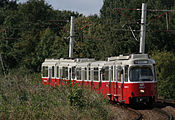 
|
||
| Type | E 6 (railcar with driver's cab) | c 6 (sidecar without driver's cab) |
| Manufacturer | Lohner / Rotax | |
| Car number (in Utrecht) | 4901-4948 | 1901-1946 |
| Number (in Utrecht) | 48 (→ 15) | 46 (→ 10) |
| Years of construction | 4901-4903: 1979, 4904-4918: 1980, 4919-4926: 1981, 4927-4932: 1982, 4933 + 4934: 1983, 4935-4944: 1984, 4945: 1985, 4946-4948: 1990 |
1901 + 1902: 1979, 1903-1910: 1980, 1911-1917: 1981, 1918-1922: 1982, 1923-1930: 1983, 1931-1939: 1988, 1940-1946: 1990 |
| length | 19,700 mm | 19,490 mm |
| width | 2,305 mm | |
| Weight | 28 t | 18 t |
| Wheel alignment | B'2'B ' | 2'2'2 ' |
| Doors per side | 2 double doors; 2 single doors | |
| Seats | 31 | 36 |
| Standing room | 72 | 72 |
| Drive power | 2 × 190 kW = 380 kW | nv |
| acceleration | 1 m / s 2 | nv |
| Braking delay | 2.7 m / s 2 | nv |
| Max. speed | 65 km / h | nv |
CAF Urbos 100
In 2007, an articulated car from Mulhouse was visiting Utrecht. This Citadis railcar was intended to promote the car-free Sunday . In addition, such a low-floor articulated car was presented to the public.
In 2015, 27 five-part Urbos 100 with a length of 33 meters were ordered for line 22 to De Uithof. They were delivered in 2017 and 2018. Another order for 22 seven-part Urbos 100 for lines 60 and 61, which are to be used from 2020, followed in 2017. The second series was delivered in 2020 and can run in double traction with the five-part vehicles.
| Technical data of the CAF low-floor wagons in Utrecht | ||
|---|---|---|
 
|
||
| Type | CAF Urbos in five parts | CAF Urbos in seven parts |
| Manufacturer | Construcciones y Auxiliar de Ferrocarriles | |
| Wagon number | 6001-6027 | 6051-6072 |
| number | 27 | 22nd |
| Years of construction | 2016-2018 | 2019-2020 |
| length | 32,970 mm | 41,190 mm |
| width | 2,650 mm | |
| Doors per side | 2 double doors | 3 double doors |
| Seats | 62 | 82 |
| Standing room | 154 | 195 |
| Max. speed | 70 km / h | 70 km / h |
| Line use | 22nd | 60 61 |
photos
Rail grinding car taken over from Essen , in Nieuwegein since 2009
Web links
Individual evidence
- ↑ Gábor Sandi: Utrecht 1936. In: The GS Tram Site. August 23, 2010, accessed May 9, 2020 .
- ↑ Qbuzz definitief vervoerder regio Utrecht. Bestuur Regio Utrecht, May 2, 2013, accessed May 9, 2020 (Dutch).
- ↑ Urban planning on the west side of the station is progressing. Utrecht municipality, April 1, 2011, accessed March 13, 2013 (Dutch).
- ↑ Wolfgang Spier: Waarom de bus will be ingeruild voor één sneltramlijn. DUB, June 12, 2019, accessed May 9, 2020 (Dutch).
- ↑ Utrecht tram contracts placed. Railway Gazette International , October 10, 2012, accessed May 8, 2020 .
- ↑ O. Kars: Utrecht vertramt drukke buslijnen. Groningertram.com, April 21, 2012, accessed May 8, 2020 (Dutch).
- ↑ Tramlijn 22 is open! Projectorganisatie Uithoflijn, December 16, 2019, accessed on May 8, 2020 (Dutch).
- ^ Freke Remmers: Nieuwe tram rijdt z'n first meters op de Uithoflijn. AD , October 2, 2017, accessed May 8, 2020 (Dutch).
- ↑ Eerste van rode Utrechtse Uithoflijn, ter vervanging van 'sardientjesbus'. NOS Nieuws , December 14, 2019, accessed May 8, 2020 (Dutch).
- ↑ Onderhoudswerkzaamheden tram 60 en 61. U-OV , accessed on May 8, 2020 (Dutch).
- ↑ Adapt baan voor nieuwe trams. Provincie Utrecht , accessed May 9, 2020 (Dutch).
- ↑ Utrecht: Another fatality after the tram attack. Mercury, April 23, 2019, accessed May 9, 2020 .
- ↑ Test rides in het weekend op tramlijn 22. U-OV, February 3, 2020, accessed on May 9, 2020 (Dutch).
- ↑ Gewonden na botsing bus en tram. RTV Utrecht, September 14, 2010, accessed on May 9, 2020 (Dutch).
- ↑ CAF signs Utrecht tram contract. Railway Gazette International, January 30, 2015, accessed May 9, 2020 .
- ↑ Quintus Vosman: Utrecht to rebuild almost line tram. In: Railjournal International. October 26, 2016, accessed February 25, 2019 .
- ^ Katie Sadler: Utrecht places additional order for 22 Urbos 100 trams. Intelligent Transport, January 20, 2017, accessed May 9, 2020 .
